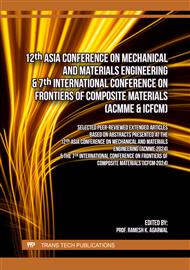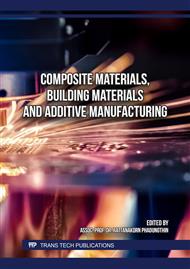p.3
p.9
p.15
p.21
p.29
p.41
p.49
p.61
Manufacturing Aluminum-Based Nanocomposites via Stir-Squeeze Casting Combined with Ultrasonication
Abstract:
This study successfully produced aluminum nanocomposites using a stir-squeeze casting process, both with and without ultrasonication (US) assistance. The matrix material utilized was scrap automobile wheel aluminum alloy (A356), with 1% SiC nano particles, averaging a size of 40 nm, serving as the reinforcement material. A comparison was made by also producing A356 aluminum casts with and without the use of US. The produced casts underwent thorough chemical and mechanical characterization, including optical and scanning microscopy, porosity measurement, hardness measurement, compression and tensile testing, as well as wear testing. Additionally, energy-dispersive X-ray spectroscopy (EDS) and X-ray diffraction (XRD) analyses were conducted to assess compositions and confirm the presence of SiC nano particles in the aluminum matrix. Porosity levels were slightly higher in the nanocomposite samples compared to pure matrix samples, attributed to the tendency of pore formation due to improper distribution of ceramic particles, resulting in clustering and agglomeration. However, significant reduction in porosity was observed with the application of ultrasonication, effectively breaking up clusters and agglomerations of reinforcement particles. Regarding mechanical properties, the A356+SiC sample with US exhibited the highest hardness (70.8 HRB), tensile strength (163.25 MPa), and compressive strength (387.2 MPa), along with the lowest abrasive wear loss (0.0017 g) among all types of casts produced in this study.
Info:
Periodical:
Pages:
21-26
Citation:
Online since:
November 2024
Authors:
Price:
Сopyright:
© 2024 Trans Tech Publications Ltd. All Rights Reserved
Share:
Citation:



